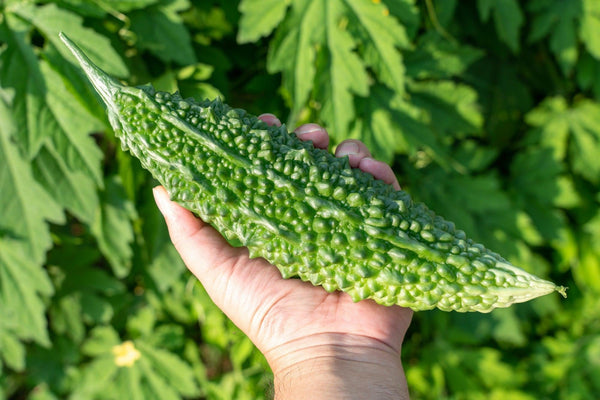
Jump to:
The vegetable Goya, despite sometimes being referred to as “bitter gourd” or “bitter melon”, has an appearance that more closely resembles a kind of prickly cucumber. Despite its sharp, bitter flavor, which makes it something of an acquired taste even among Japanese consumers, it has long been a staple of Okinawan food, and its health-giving properties are considered a factor by many people for Okinawa traditionally being ranked among the world’s “blue zones” for longevity. (For information on a wide range of Japanese vegetables, check out our post on Japanese vegetables.
In this blog post, we shall look at where Goya is grown and its origins, popular dishes, how to prepare and store Goya, and health benefits and possible risks, as well as alternative ways of enjoying Goya.
Origins And Main Areas Of Cultivation

Although Goya (also called “Nigauri” in Okinawa) has the image of being a summer Okinawan vegetable, it first originated in northeastern India. It was then introduced to China around the time of the Ming dynasty (late 14th century) and is said to have arrived in Okinawa via China in the first half of the 15th century and, following that, to mainland Japan during the Keicho era (1596-1615).
Goya tends to thrive in hot and humid climates. As of 2018, approximately 40% of the Goya cultivated domestically in Japan was grown in Okinawa, with the majority of the remainder being produced in the warmer southern islands of Kyushu.
How To Prepare And Store Goya

In this section, we will look at how to prepare Goya. One of the most important steps in preparing any type of food is to choose the best ingredients. So how do you know how to select the best Goya when you are comparing them in the vegetable aisle of the supermarket?
Goya should be bright dark green and have a heavy feel. It is fresher when the wart-like bumps on its surface are firm, and uniformly sized, without being crushed or damaged.
The fresher the Goya is, the more nutritious (and more bitter) it will be.
A common way of preparing Goya is to cut it in half and remove the fluffy inner section that contains the seeds, as well as the rind. If you are feeling brave, however, these parts of the plant are edible and highly nutritious.
Goya can be stored at room temperature for about two days. However, if the temperature rises above 28°C (82°F), it will ripen and turn yellow, so if you want to keep it longer, refrigerate or freeze it. It will last for about one week to ten days in the vegetable compartment of your refrigerator, or about one month if frozen.
Goya – A Nutritional Powerhouse

Goya is a staple of Okinawan food, and even today in Okinawa, elderly people refer to food as "kusuimun" (or "nuchigusui") in their local dialect. This word has the meaning of "medicine" or "medicine for life," reflecting the concept that the purpose of food is primarily to prevent and cure illness. They may be on to something. According to a survey from 1980, Okinawa had the highest average life expectancy for both men and women, with men generally expected to reach at least 84 and women tending to live until the age of 90. Sadly, the Western and mainland Japanese influences on the diet, particularly among younger people, have led to a decline in average longevity in recent decades.
The bitter component of Goya, momordicin, stimulates digestion, protects the lining of the stomach, and improves the appetite. It is also said to help shift glucose from the blood to store in the cells by stimulating the production of insulin, which may account for the reported low levels of diabetes in populations adhering to the traditional Okinawan diet. It also contains high levels of water-soluble vitamins such as vitamin C. Vitamin C is usually vulnerable to heat, but vitamin C in bitter melon is more resistant to heat than other vegetables, so can be enjoyed in stir-fry dishes without losing its nutritional benefits.
As mentioned, when looking at how to select the best Goya, the fresher and therefore more nutritious Goya is also the most bitter. In this sense, it is really a case of “No pain, no gain” when looking to reap the health benefits of this food. Invariably, measures taken to reduce the bitterness in Goya, such as boiling it, have a nutritional trade-off. The Vitamin C and momordicin in Goya are strong against heat, but vulnerable to the effects of water, and the benefits of both of these nutrients are reduced by boiling.
So, is there any way to fully enjoy the health-giving properties of Goya without being overwhelmed by its bitter taste? The secret to that lies in preparing it in a way that gives you full nutritional value while combining it with other foods that help mask the bitterness of Goya. Some popular dishes are described below.
Popular Dishes Featuring Goya

Probably, the most famous dish that uses Goya is Goya-Champuru, which is a signature dish in Okinawan cuisine. Salt is added to the thinly cut Goya and it is then stir-fried together with tofu, pork, and egg to temper some of its bitterness. The word “champuru”, said to derive from the Indonesian word “campur”, means “jumble” in the Okinawan dialect. The true Okinawan version of Champuru uses “island tofu”, a stronger type of tofu native to Okinawa, but as this is hard to get outside Okinawa, it can be replaced by ordinary tofu. The blending, or jumbling, of all of these flavors with the Goya distracts from the bitterness of the vegetable and makes it easier to eat.
Another way of getting the full nutritional punch of Goya without bitterness is to combine it with a strong taste. In Goya Curry, even when made with store-bought curry roux, the strong curry flavor masks the bitter flavor of the Goya. This is traditionally eaten with summer vegetables, such as cherry tomatoes, and pork, which is the staple meat used in Okinawan cooking, but you can substitute beef or chicken and your other favorite vegetables if you wish.
Can You Have Too Much Of A Good Thing?
Goya is rich in a variety of nutrients, but one should be careful not to overeat it. This is because eating too much can cause gastrointestinal symptoms such as diarrhea, and abdominal pain.
The reason for this is that heavy consumption of the nutrient momordicin, described above, can cause excessive secretion of gastric juice, and this puts a strain on the stomach. It is best, therefore, to eat this highly nutritious vegetable in moderation.
This, of course, begs the question of what a moderate amount is. There is no uniform upper limit to the amount that can be consumed, so it is advisable to adjust the amount according to one's particular body type and physical condition. For example, people with weak constitutions should probably consume less Goya.
Other Ways Of Enjoying Goya

There are other ways to enjoy Goya in addition to using it in your food. These include Goya tea, Goya smoothie, and Goya chips.
Goya tea is a simple way of receiving the health-giving properties of Goya in a concentrated beverage form. The steps for making this tea, which is surprisingly not very bitter, are as follows: Cut the Goya in half and remove the seeds (but don’t throw them away). Thinly slice the Goya, and leave the Goya pieces, as well as the seeds, to dry in the sun. If this is not possible, you can use the microwave instead. After they are fully dried, gently brown in a frying pan and you are good to go. A Goya weighing 230 g can be used to make about 15 g of tea.
You can also make a healthy Goya smoothie that is easy to drink by combining it with sweeter food, such as bananas. Simply peel the banana, place it in a freezer bag, and freeze. Remove the seeds from the Goya, but leave the white part as is. Cut the Goya and frozen banana into small pieces and mix in a blender, after adding milk.
Goya Champuru Chips, made by the company Nanpudo, are a delicious alternative way of enjoying Goya. Nanpudo is a company whose goal is to deliver traditional Okinawan snacks and crafts in new and fresh ways to a wide variety of consumers. Their Goya Champuru Chips use Goya from Okinawa to recreate this signature dish in snack form. Have we tempted you?
Goya – A Vegetable Worth Learning To Like

Goya is so inextricably linked to the food culture of Okinawa that it is probably one of the first things that most people think of when discussing Okinawan cuisine. In fact, it is such a part of Okinawan culture, that May 8th every year is designated as “Goya day” (the words “go” and “ya” are used for “5” and “8” in Japanese).
Because of its bitter taste, Goya tends to be one of those “love it or hate it” foods that divides opinion among foodies. However, given its sterling nutritional profile, it is certainly worth exploring ways to incorporate it into your diet.
Have you tried Goya yet? Are you able to embrace its bitterness, or is it a hurdle too high for your taste buds? Let us know in the comments.


2 comments
Hi Kenneth,
Thank you for your question. To save Goya seeds for next year, choose fully ripe fruits that have turned yellow or orange. Cut them open to extract the seeds, and rinse off the red pulp. Spread the seeds out to dry for about a week in a well-ventilated area. Once dry, store them in a cool, dark place, like a paper envelope or airtight container, labeled with the date and type of seed. Before planting, check for viability by sprouting a few seeds in a damp paper towel.
We hope this helps!
Japanese Taste,
My wife is Japanese and for the last 15 years we have been growing Goya successfully here in Southeastern Pennsylvania. I’d like to know how to save the seeds to plant next year.
Kenneth ,